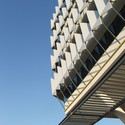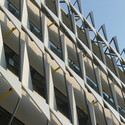The Middle East has always been known for many things - sustainability will not be one of them. The clash of Western values with the harsh local climate can often stall sustainability among a lot of sand and a hard place. Although there is a broad critique of unsustainable attributes of the way of development of the region, for years there has been a brilliant exception: Masdar City in the United Arab Emirates, seventeen kilometers is- southeast of the city of Abu Dhabi.
is Masdar City as an urban development project managed by the renewable energy company Masdar, which has committed $ 15 billion to the new Masdar City sustainable city on the planet . Unlike Abu Dhabi, a city that follows thoughtlessly archaic models and Western design principles, Masdar City has a wealth of potential to offer the world of green urban planning -. Something the world desperately needs
But Masdar City is certainly not without its share of critics. At the first approach, the concentrated development, located in the center of six square kilometers of empty space, does little to fear, especially compared to the sprawling wave that Abu Dhabi. largely thank you to the global financial recession, the buildings currently represent less than 10% of the area committed to the urban experience. Even today, there is a group of spectators who suggest Masdar City may just be a mirage after all.
However, this broader perspective is not necessarily synonymous with the bigger picture.



 11
11
Design of Oasis
Since its creation, the master plan of the city was led by Foster + Partners, who also designed all buildings to date (with the exception of Siemens building the most recent). Nothing in the city seems to have been conceived without thoughtful intention. The face of each building, the end of the street and the layout of each public space is part of a balanced composition. Nothing seems to be out of or foreign. One could argue that having only one hand behind the design effort has compromised the possibility for random urban event, involuntary residual condition, the undesigned coincidence that so often defines urban spaces we love. At the same time, which today is only a fraction of fabric provided the city expected to house 40,000 residents and more than 50,000 daily commuters.
Walking in the city, the City Manager Design Masdar, Chris Wan, shows me the different components of each building working on the creation of a sustainable urban environment in a less hospitable climates of the world. Some structures are clad in terracotta panels that serve private balconies, others in delicate metal screens, and some reflective wall panels filled with air tests (used to lower the thermal mass of the outer wall, while simultaneously reflecting the sunlight away from). Chris points out that "Like any good sustainable architecture, all these make more than one thing at once."
The buildings at the top of existing base of about 4 or 5 floors above street level. the absence of cars makes the main flow to be narrower, which brings the added benefit of passive solar protection to the surface of the street. According to Wan, the streets become only 30- 45 minutes of direct sunlight per day in the desert climate, contribute to the fact that temperatures are 10-15 degrees lower supposedly inside Masdar City in Abu Dhabi (a testament to the power that heat islands have to handle climates local).
Big Results Simple Moves
Coupled with the PVs on the tops of most of the buildings themselves, a solar plant of 10 MW impressive is sitting on the edge of the development area, the production of cleaner energy the city uses on a daily basis. The main axis of the city is rotated to align the grid with the prevailing wind. Ultimately, Wan suggests that passive design strategies could contribute most to the long term success of the city: "Many of the savings come from the simple architecture," Wan insisted Things like orientation. building, sunscreen and materiality go a long way to lift heavy loads without an army of gadgets and gizmos.
the functionality is designed into the whole plan throughout its many phases and iterations. When the London-based firm Sheppard Robson proposed design for the new Middle East headquarters of Siemens they chose to raise their building a story on the ground to operate natural breeze and circulate through the structure using the Venturi effect. in the process, they also created a shadow public space at street level with stunning views of the rest of site. Everything sounds good as a sound bite, but when you stand under the building and hold your arms with the mobile breeze on you, there's no denying it actually works. Wan was right when he proudly said: "You do not see the blueprint, you feel the master plan. No drawing can replace it. "
Although the Siemen's building is the first LEED Platinum building in Abu Dhabi - no small accomplishment in the middle of the desert - Wan did not see the as the finish line regarding future ahead buildings, Wan exclaimed.. "We'll blow LEED Platinum out of the water"
Yet those who come to the site looking for some breakthrough technology that can not be found anywhere else in the world may be disappointed. But the fact is that not only is there no quick fix, but we did not need a progress, much progress. Masdar City embodies this reality and this is its greatest value. Its physical design separates the countless theoretical (well-meaning) urban models waiting to be built.
Sustainable standard, Slow & Steady
Masdar City is a sustainable urban spaces so most impressive proactive and still managed to build. City officials hope to have the majority of the work accomplished by the year 2030. However, in its promise of rapid growth may be the greatest risk to its authenticity. expanding too quickly
Some people can poke at Masdar to downshift in response to the global financial crisis, but this slower pace may well have been a boon to the urban landscape grass allowing more time to study the effects of the gradual growth of the city. While everyone would like to see the city complete, with the project grow up too fast could be the fastest way to compromise its values, turning it into more of a theme park of an authentic urban environment. The project will do more for the world of sustainability by being a better home rather than better Epcot Center; a better place to live rather than a better place if it continues to slowly and steadily grow and learn, Masdar City will one day become a model for replication "come and see." - or quickly become a simple exhibition of good intentions.
focusing on sustainable design, Tyler Caine AIA LEED AP is an architect who is working on COOKFOX Architects in New York. He wrote about the cultural interface of sustainability on his blog Intercon.
Posting Komentar